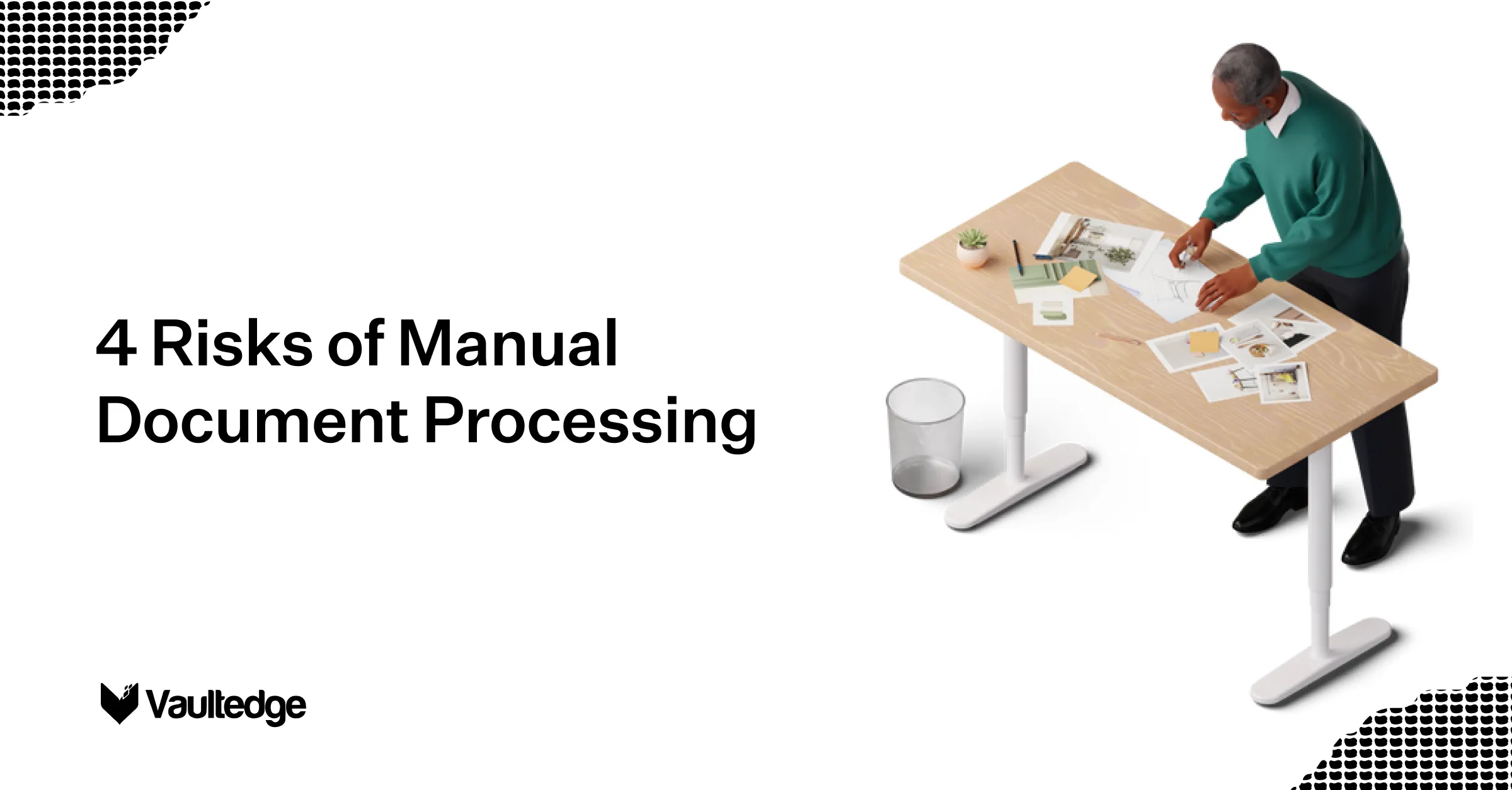Document processing is crucial for financial institutions, impacting loan approvals and regulatory compliance. Yet, outdated manual methods are falling short. This blog post targets finance sector leaders like loan officers, CTOs, and CEOs. It will discuss the risks of manual document processing and suggest automated solutions to boost efficiency while reducing risks.
Unpacking Manual Document Processing
Before exploring the risks and solutions related to this important financial aspect, let's grasp the significance of manual document processing. It's a laborious, time-intensive task involving human input at each stage, from inputting data to analysis and storage. The effects of this manual procedure are complex and can impact various areas of an organization's operations.
Manual Processing Risks:
Traditional document handling is time-consuming and prone to errors. The complexity of financial documents, coupled with the vast amount of information and compliance intricacies, makes manual processing a risky venture. Every manual task introduces the potential for errors, which in the finance sector, can result in severe consequences.
Document Workflow:
Consider a loan application: a document reaches a loan officer's desk, gets reviewed, information is manually inputted into the system, analyzed, approved or rejected, and then stored. At each stage, there's a chance of bottlenecks, mistakes, or security vulnerabilities.
Impacts:
A single typo in a mortgage contract can be financially devastating for borrowers and reputationally damaging for institutions. Investment bankers face the risk of losing millions due to misfiled reports, while retail banks risk customer trust erosion from confidentiality breaches. These risks threaten the very existence of organizations.
How Automation Works
Automated document processing eliminates manual handling risks. By using technology, documents are processed quickly, accurately, and with higher security levels than humans. This section will explain the benefits of automated systems for financial institutions.
Increased Efficiency
Automation processes documents almost instantly, reducing tasks that take hours or days for humans to mere minutes. This speed not only saves time but also helps allocate resources more efficiently for better profitability.
Reduced Data Errors
AI-driven automation lowers error chances to less than 1%, crucial in sectors where a small mistake can lead to significant consequences.
Enhanced Security
In the face of cyber threats, strengthening document security is crucial. Automated systems provide advanced security measures that are regularly updated to combat evolving dangers.
The 4 Unavoidable Risks of Manual Document Processing
Financial institutions that stick to manual document processing face numerous risks. Let's look at the main risks and how intelligent automation can help avoid them.
Risk 1: Inefficiency and Time Consumption
Financial tasks like transactions, loans, and compliance checks are time-critical. Any delay can lead to significant losses. Manual processing almost always results in inefficiency, causing delays in decisions and missed opportunities.
The True Cost of Time
Time equals money, but in finance, it's much riskier. For a bank in the stock market, late reporting due to manual processing can lead to a sharp drop in stock prices. Efficiency is a must, and automation excels here.
The Efficiency of Automation
Automated systems work non-stop, speeding up processes significantly. They don't get sick, take breaks, or need time off, ensuring financial institutions run at top efficiency.
Risk 2: Data Errors and Inaccuracies
Manual data entry has its flaws. It introduces human error into systems that require precision. In finance, a minor mistake can escalate, causing more significant, widespread issues.
Studies show that manual data entry errors can occur as frequently as 1 in every 100 keystrokes. In high finance, even a simple comma can completely alter the meaning of a directive. This room for error is unacceptable.
Risk 3: Security Vulnerabilities
Financial data security is crucial. Any breach could harm client trust, damage the brand, and even lead to legal consequences.
Manual processing poses security risks, as multiple individuals handle documents, each a potential system weak point.
Automated systems establish strict protocols and defenses to safeguard data. They use encrypted storage and server-side security to create a strong defense against malicious intent.
Risk 4: Compliance Curtails
Governments worldwide are tightening security around data storage with new laws and guidelines, regularly updated to ensure compliance. With manual document processing, keeping up with these myriad compliances becomes a challenge. This not only leaves companies vulnerable to litigation and penalties but particularly affects those in legal, identity, and finance sectors. Take, for instance, the critical need for data privacy initiatives. Data privacy, crucial for all organizations, demands readiness for newer, tighter regulations alongside existing ones like GDPR, HIPAA, and SOX. Each region's unique privacy laws, such as the California Privacy Rights Act (CPRA) in the US, require specific compliance measures. To navigate these regulations effectively, a clear overview of data status and secure, up-to-date data tools are key.
Automated document processing ensures high data integrity, maintaining complete, accurate data with robust safeguards against deletion or tampering. Electronic systems adeptly adapt to evolving laws, safeguarding customer data effectively. Manual processing complicates audits, posing challenges like document misplacement or damage risks. In contrast, automated systems maintain audit trails, facilitating investigations, and providing easy access to documents through cloud-based platforms during audits.
Conclusion
In conclusion, the hazards of manual document processing in the financial sector are not just operational; they are existential. By adopting advanced automated systems like Vaultedge Document AI, financial institutions can simplify their workflow, reduce risk, and ensure a more prosperous future.
Vaultedge Document AI is an industry-specific document processing solution designed for the mortgage sector, offering robust capabilities in managing unstructured documents and providing an end-to-end loan processing solution. Their AI and machine learning expertise guarantee precise data extraction from documents, enhancing efficiency and accuracy in lending activities.
The time for change is now, and Vaultedge's tools are at your disposal. Take the next step to secure the future of finance - book a demo or exploration call with Vaultedge today.



